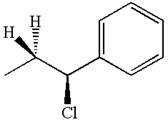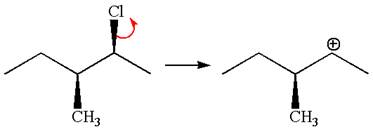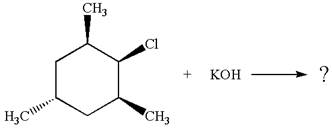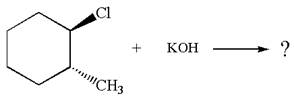
Concept explainers
(a)
Interpretation:
The detailed mechanisms for the given reaction occurring via
Concept introduction:
The
In case of
Answer to Problem 8.44P
The


The

Explanation of Solution
The given reaction equation is:

In the given reaction,

The hydrogen atom, indicated with the dash bond, is anti to

If the hydrogen atom, indicated with wedge bond, tends to eliminate, it must orient anti to

In

The products formed for the given reaction from both
(b)
Interpretation:
The detailed mechanisms for the given reaction occurring via
Concept introduction:
The
In case of
Answer to Problem 8.44P
The

The

Explanation of Solution
The given reaction equation is:

In the given reaction,

In

The products formed for the given reaction from both
(c)
Interpretation:
The detailed mechanisms for the given reaction occurring via
Concept introduction:
The
In case of
Answer to Problem 8.44P
The


The



Explanation of Solution
The given reaction equation is:

In the given reaction,


In

In the second step, the base abstracts the proton from the carbon adjacent to the positively charged carbon. Two products are possible because the proton gets eliminated from two different carbon atoms. The detailed mechanism is shown below:


The products formed for the given reaction from both
(d)
Interpretation:
The detailed mechanisms for the given reaction occurring via
Concept introduction:
The
In case of
Answer to Problem 8.44P
The


The





Explanation of Solution
The given reaction equation is:

In the given reaction,


In

In the second step, the base abstracts the proton from the carbon adjacent to the positively charged carbon. Two products are possible from the secondary carbocation because the proton is eliminated from two different carbon atoms.


The carbocation formed is a secondary carbocation, which can be rearranged to a more stable tertiary carbocation by

Two products are possible from the tertiary carbocation because the proton is eliminated from two different carbon atoms.


Thus, in all the reactions above, the products are formed by
The products formed for the given reaction from both
(e)
Interpretation:
The detailed mechanisms for the given reaction occurring via
Concept introduction:
The
In case of
Answer to Problem 8.44P
The


The



Explanation of Solution
The given reaction equation is:

In the given reaction,


In

In the second step, the base abstracts the proton from the carbon adjacent to the positively charged carbon. Two products are possible because the proton is eliminated from two different carbon atoms. The detailed mechanism is shown below:


The products formed for the given reaction from both
(f)
Interpretation:
The detailed mechanisms for the given reaction occurring via
Concept introduction:
The
In case of
Answer to Problem 8.44P
The

The





Explanation of Solution
The given reaction equation is:

In the given reaction,

In

In the second step, the base abstracts the proton from the carbon adjacent to positively charged carbon. Two products are possible because the proton is eliminated from two different carbon atoms. The detailed mechanism is shown below:


The carbocation formed is a secondary carbocation, which can be rearranged to form more stable tertiary carbocation by

Two products are possible from the tertiary carbocation because the proton IS eliminated from two different carbon atoms.


The products formed for the given reaction from both
Want to see more full solutions like this?
Chapter 8 Solutions
Get Ready for Organic Chemistry
- Draw the missing intermediates 1 and 2, plus the final product 3, of this synthesis: 0 1. Eto 1. Eto- 1 2 2. MeBr 2. EtBr H3O+ A 3 You can draw the three structures in any arrangement you like. Explanation Check Click and drag to start drawing a structure.arrow_forwardDraw the missing intermediate 1 and final product 2 of this synthesis: 1. MeO- H3O+ 1 2 2. PrBr Δ You can draw the two structures in any arrangement you like. Click and drag to start drawing a structure.arrow_forwardWhat is the differences between: Glyceride and phosphoglyceride Wax and Fat Soap and Fatty acid HDL and LDL cholesterol Phospho lipids and sphingosine What are the types of lipids? What are the main lipid components of membrane structures? How could lipids play important rules as signaling molecules and building units? The structure variety of lipids makes them to play significant rules in our body, conclude breifly on this statement.arrow_forward
- What is the differences between DNA and RNA for the following: - structure - function - type What is the meaning of: - replication - transcription - translation show the base pair connection(hydrogen bond) in DNA and RNAarrow_forwardWhat is the IP for a amino acid- give an example what are the types of amino acids What are the structures of proteins The N-Terminal analysis by the Edman method shows saralasin contains sarcosine at the N-terminus. Partial hydrolysis of saralasin with dilute hydrochloric acid yields the following fragments: Try-Val-His Sar-Arg-Val His-Pro-Ala Val- Tyr- Val Arg-Val-Tyr What is the structure of saralasin?arrow_forwardWhat is the IP for a amino acid- give an example what are the types of amino acids What are the structures of proteins The N-Terminal analysis by the Edman method shows saralasin contains sarcosine at the N-terminus. Partial hydrolysis of saralasin with dilute hydrochloric acid yields the following fragments: Try-Val-His Sar-Arg-Val His-Pro-Ala Val- Tyr- Val Arg-Val-Tyr What is the structure of saralasin?arrow_forward
- > aw the missing intermediates 1 and 2, plus the final product 3, of this synthesis: 1. Eto 1. EtO¯ H3O+ 1 2 2. PrBr 2. PrBr Δ You can draw the three structures in any arrangement you like. 3 Click and drag to start drawing a structure. Explanation Check 2025 McGraw Hill LLC. All Rights Reserved. Terms of Use Privacarrow_forwardThere are various factors that affect an equilibrium. Give 3 of these factors and explain using examples andequations how an equilibrium is affected by these factors. Please remember that this is a communication question so that you are communicating your understanding of the factors that affect and equilibrium.arrow_forwardEEZE LETCHUP ID Draw the most likely conjugate base resulting from this acid-base reaction. Include all lone pairs. Ignore inorganic byproducts. Drawing く NaOCH2CH3 :0: :0: 狗arrow_forward
- Answerarrow_forward2. Provide a clear arrow-pushing mechanism for the following reactions. Do not skip proton transfers, do not combine steps, and make sure your arrows are clear enough to be interpreted without ambiguity. a. CH3 Ph OEt هد Ph CH3 Hint: the species on the left is an ynolate, which behaves a lot like an enolate.arrow_forwardb. CH3 H3C CH3 CH3 H3C an unexpected product, containing a single 9- membered ring the expected product, containing two fused rings H3C-I (H3C)2CuLi an enolatearrow_forward
 Organic Chemistry: A Guided InquiryChemistryISBN:9780618974122Author:Andrei StraumanisPublisher:Cengage Learning
Organic Chemistry: A Guided InquiryChemistryISBN:9780618974122Author:Andrei StraumanisPublisher:Cengage Learning
